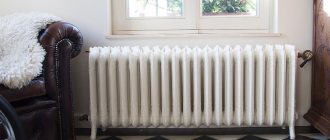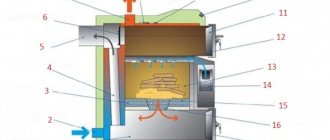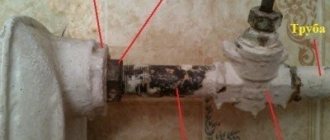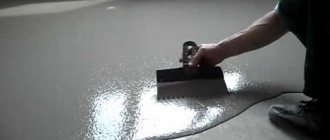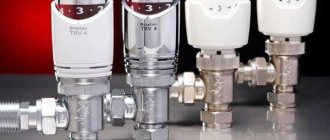Home » Electric heating » Inverter boiler for home heating
For those areas where there is no access to a gas main, one of the best ways to heat a home is to purchase electrical equipment. Electricity is the type of fuel that is present in every home.
In addition, you do not need to prepare special documentation and permits to install the device on electricity. Boilers of this type are affordable and compact in size.
If you look at it from the point of view of electricity consumption, then many owners are scared off by its high cost according to the tariff plan. But despite this, manufacturers of heating systems strive to increase the efficiency of installations and reduce heat loss. Therefore, one of the most promising devices for heating a home are inverter boilers.
Below we will consider the operating principle of an inverter boiler, the disadvantages and advantages of its use, as well as the organization of this heating system.
Inverter heating boiler
Advantages and disadvantages
Let's start with the advantages, and there is a lot to list here.
Cost-effectiveness is the most important advantage. When the temperature reaches a certain or specified limit, the device switches to a mode with lower power consumption
It will remain quite comfortable in a heated place. There is no need to use the device frequently, and it does not waste much electricity. When compared with analogues, the level of operation and efficiency of this device is higher than that of other home heating units.
Practicality is first and foremost convenience. Even in low temperature conditions in a heated room, the heater will continue to operate at lower power. Environmental friendliness along with safety. No fuel combustion occurs.
During operation, the noise emitted is minimal, which ensures special comfort. High efficiency.
After the advantages, we can also mention the disadvantages.
- High price. For so many benefits you need to pay a lot of money.
- Weak resistance to network fluctuations. In case of any decline, you will need to adjust the temperature and the device itself again.
- Expensive repairs. Since these units themselves are expensive, it is also not easy to find the necessary good quality parts for them. This can take a lot of time and money. Repair work may take several weeks and will not be cheap.
- Inability to start the compressor at temperatures below -10 and above +42 degrees.
Distinctive feature
The inverter heating system consists of convectors connected by a single control. A convector is an electric heater whose operating principle is based on convection, that is, heating and mixing hot and cold air masses.
When heating with electricity, all electrical energy is converted into heat. Therefore, every extra degree means additional energy costs. Extra degrees occur when the operation of the device is controlled by a conventional thermostat. Such a convector first overheats the air by several degrees above the set value, wasting more energy, then turns off, giving time for the temperature to drop by several degrees. A new heating cycle follows, and so on. In such cycles, excess electricity is wasted and the electronics of the device wear out faster.
Control unit with digital INVERTER technology
A convector with an inverter control unit and a highly sensitive temperature sensor does not have this drawback. To maintain the set temperature, the heating element of the inverter convector does not need to be constantly turned on, using maximum power, and then turned off to cool. The inverter control unit smoothly reduces the power of the heating element as the current temperature approaches the set one and then works to accurately maintain the temperature with a constant minimum electricity consumption.
If we compare inverter heating with a boiler, then the system based on an electric boiler and radiators is much more inert, it reacts more slowly to changes in internal temperature and therefore consumes more electricity than is necessary to maintain a comfortable temperature.
Analysis of the arguments "for" and "against"
Let's start with the cons. In addition to the material consumption, which affects the cost of the project, there is the need to install a manifold cabinet, which will require additional space.
This is where the disadvantages of the beam system end, and a series of advantages begin:
- simple design and installation, the system uses pipes of the same diameter;
- with hidden installation there are no connections in the walls and floor;
- high installation speed due to the minimum number of connections;
- expansion of functionality due to the installation of shut-off valves, sensors, air vents and thermal heads to automate the operation of the heating system;
- temperature control in each individual room using mechanical elements or automation;
- the ability to cut off any radiator without stopping the heating process;
- uniform heating of all rooms.
The external control panel allows you to program the heating operation, including automatic adjustment depending on the weather conditions outside. Thanks to the installed sensors, all residents can set any parameters that are comfortable for them while in a specific room.
The radiant system is materially expensive in terms of implementation, but is ahead of all other options in flexibility of settings and ensuring the efficiency of all heating
Thus, the radial wiring diagram makes it possible to achieve high controllability of the heating system and achieve optimal coolant flow.
Autonomous power supplies
Often, for an electric heating system to operate normally, it must periodically switch to an alternative power source, and batteries in this case will be much more convenient than generators. The explanation for this reason is obvious: generators are very dependent on the availability of fuel, which must be purchased, delivered, stored and refueled.
Batteries make it possible to eliminate human actions, since all switching in this case will be carried out automatically. In addition, batteries are much better from an environmental and economic point of view, despite their high cost.
Conclusion
Inverter heating is an excellent solution for heating your home. The cost of purchasing and installing such a design is usually quite high, but in the long run these costs are offset by the good performance of such a system.
Principle of operation
Inverter heaters operate on a very simple principle, which is to convert direct current into alternating current, thereby changing the frequency and voltage. The operation of an inverter is very similar to that of an air conditioner. The main structural element is a pump, consisting of internal and external blocks. The internal one contains a heat exchanger in which freon accumulates under the influence of high pressure. Its temperature can reach up to 80°C.
Freon is a liquid substance circulating through a heat exchanger
The accumulated substance is then sent to the external unit, where the pressure is much lower. It is at this point that freon is converted from a liquid state to a gaseous state. As a result, a large amount of heat is released.
The inverter can control the heating process automatically. This means that if the set room temperature is reached, the system does not turn off, but simply switches to a lower power level. Thanks to this ability, the room always maintains the optimal temperature. The main feature of such heaters is minimal energy consumption, and the fact that they do not need to be constantly turned on and off.
Microclimate in the house
A heating system based on inverter convectors makes it easy to control the home microclimate. Often it makes no sense to maintain the same temperature in all rooms. It makes more sense to divide the house into separate zones. For example, in the bathroom it can be 25 degrees, in the living room and bedroom 22˚C, and in utility rooms 18˚C is enough. This effect can be achieved in several ways.
- Through a special HOMMYN mobile application and additional WiFi modules installed in the control unit. The application allows you to combine devices into zones, set the temperature and operating mode of the devices for each zone at once.
- Using Electrolux smart thermostats. A thermostat with a built-in temperature sensor controls the convectors combined into a common zone. Thermostats allow you to maintain the set temperature as accurately as possible and quickly respond to its changes; increase energy efficiency and minimize energy costs. In this case, you can control the heating system both through the application and directly from the thermostat. Smart thermostats stably control convectors even in the absence of an external Internet connection.
- Special remote control for centralized climate control HOMMYN. This device controls the operation of all convectors and thermostats of the system, continuously calculates the energy consumption required to consistently maintain a comfortable temperature. In addition, the central console increases energy efficiency and reduces energy consumption. And the remote control also makes it possible to flexibly configure the heating operation according to the calendar, and ensures stable communication with system devices even in the absence of an Internet connection. Situations often arise when there is not enough electrical power allocated to the house. In this case, the remote control can limit the power consumed by heating and configure cascade switching on/off of convectors. This will prevent them from operating simultaneously and will not create a peak load on the power grid that exceeds the permissible load.
- Commercial facilities and large homes are best managed by a specialized system based on the HOMMYN Professional controller. The controller supports power limitation and distribution technology and can be integrated into a building automation system (MODBUS protocol).
Distribution of convectors by zones
Advantages of using polypropylene in heating systems
There are many such advantages:
- Easy installation. As already mentioned, even one person with a soldering iron can handle it, while installing steel pipes will require a welder.
- Heating with plastic pipes will cost you several times less.
- This material is not subject to corrosion, so it can last up to fifty years.
- Its use has a positive effect on the heat transfer of the system.
- Such pipes do not “overgrow”, that is, salts are not deposited on their inner surface.
- Finally, polypropylene, although flexible, is also very strong, so it can be used under high pressure or temperature.
Video on pipe selection
https://youtube.com/watch?v=fKf2kG7gHvw
All this contributes to the fact that heating systems using polypropylene pipes are becoming more common today.
What pipes should be used for heating systems?
When choosing polypropylene pipes, you need to compare the operating features of your future heating with the conditions under which this or that material can be used. For heating systems, it is advisable to use the following types of pipes:
- PN25.
- PN20.
The fact is that they perfectly tolerate a coolant temperature of ninety degrees, and for some time (albeit limited) they can withstand an unexpected jump to one hundred degrees. Such pipes should be used under conditions where the pressure does not exceed 25 and 20 atmospheres, respectively. But if you choose between these options, then, of course, for heating systems it is better to choose a PN25 reinforced pipe.
Benefit and safety
It is worth highlighting the high reliability, durability and unpretentiousness of the inverter system. Convectors have a high class of dust and moisture protection, which makes it possible to use the equipment in damp rooms. Inverter convectors have passed all the necessary tests and have a fire safety certificate from the Ministry of Emergency Situations.
An analysis of the Electrolux inverter system showed that its use, including installation, is more profitable and cheaper than the operation of electric boilers. An important factor is flexibility - individual modules can easily form a system that will be adapted to a specific living space; if necessary, the house can be divided into zones and controlled, including using power limiting technology.
Heating system made of polypropylene pipes
The technical characteristics of the object and the amount of allocated funds affect the heating installation scheme. In apartments in multi-storey buildings it is connected to the Central Heating Network, and in private houses - with an individual boiler. Regardless of the type of object, the system can have one of three designs.
Single-pipe
The system is characterized by simple installation and quantity of materials. It uses one pipe for supply and return, which reduces the number of fittings and fasteners.
It represents one closed circuit with alternating vertical or horizontal placement of radiators. The second type is used specifically in private homes.
As the coolant passes through each radiator, its temperature decreases. Therefore, a single-pipe circuit is not able to heat the entire object evenly. There is also the difficulty of temperature control, since the heat loss factor is not taken into account.
If the radiators are not connected through valves, then when one battery is repaired, the heat supply is stopped throughout the entire facility. When installing such a network in a private house, an expansion tank is connected. It allows you to compensate for changes in pressure in the system.
A single-pipe circuit allows the installation of radiators with temperature controllers and thermostatic valves that allow for the correction of heat loss. Ball valves, valves and bypasses are also installed for repairing individual sections of the thermal circuit.
Two-pipe
The system consists of two circuits. One of them is for serving, and the second is for returning. Therefore, a larger number of pipes, shut-off valves, fittings, and consumables are installed. This increases installation time and budget.
The advantages of a 2-pipe network include:
- Uniform heat distribution throughout the entire facility.
- Minimal pressure loss.
- Possibility of installing a low power pump. Therefore, coolant circulation can occur by gravity.
- Repairing an individual radiator is possible without shutting down the entire system.
A 2-pipe system uses a passing or dead-end coolant flow pattern. In the first case, it is allowed to install batteries with the same heat output or radiators with different power, but with thermostatic valves.
The associated circuit is used if the thermal circuit is long. The dead-end option is used for short highways. When installing a 2-pipe network, it is necessary to install radiators with Mayevsky taps. Elements allow air to be released.
Collector
This system uses a comb. It is a collector and is installed on the supply and return. This is a two-pipe heating circuit. A separate pipe is installed both to supply coolant to each radiator and to return cooled water.
The system may consist of many circuits, the number of which depends on the number of batteries.
When installing a collector heat circuit, an expansion tank is installed. It holds at least 10% of the total volume of coolant used.
During installation, a manifold cabinet is also used. They try to place it at an equal distance from all batteries.
Each circuit in the manifold system is a separate hydraulic system. It has its own shut-off valves. This allows you to turn off any of the circuits without stopping the entire system.
Collector
Advantages of the collector network:
- It is possible to regulate the heating temperature of any heating device without damaging the remaining batteries.
- High efficiency of the system due to the direct supply of coolant to each radiator.
- It is possible to use pipes with a smaller cross-section and a less powerful boiler due to the high efficiency of the system. Therefore, the costs of purchasing equipment, materials and operating the network are reduced.
- Simple design process, without complex calculations.
- Possibility of installing heated floors. This allows you to create a more aesthetically pleasing interior, since there is no need to install traditional batteries.
To install a collector system, a large number of pipes, fittings and shut-off valves will be required. You will also need to purchase combs, a circulation pump, an expansion tank and a cabinet for manifolds.
A large number of elements increases the complexity of the installation process. The installation of batteries is carried out together with Mayevsky taps to prevent airing of each circuit.
The language of numbers
The most expensive budget items when installing heating are the purchase of equipment and installer services. The minimum you can expect when installing an electric boiler on a house with an area of 120 square meters. m. - approximately 220 thousand rubles.
The cost of inverter heating for a house with the same area, which means 7–9 inverter convectors, will be 70–80 thousand rubles. To this amount will be added minor costs for cables and sockets.
Convector control via the Hommyn mobile application
Installation
Installing an induction boiler yourself will not cause much trouble. You just need to follow a few rules:
- do not forget about the mandatory installation of an expansion tank and, in most cases, a circulation pump in the system;
- the power supply network and wiring must correspond to the power of the device; automatic protective equipment will not be superfluous;
- the boiler should be placed at a certain distance relative to the nearest objects;
- The device must be grounded.
Methods for installing inventory heaters
The absence of the need to equip a separate room for an induction boiler, its ease of maintenance, safety, noiselessness and other numerous advantages give this device an undeniable advantage over other devices of similar purpose.
Equipping it with something like an electronic programmer will also allow you to remotely control the heat in your home, which may be a pleasant addition for owners of periodically visited country houses.
Manufacturers and popular models: ranking of the best and prices
The most widespread use of inverter heaters in everyday life is in convector heaters and split systems - a new generation of air conditioners with an improved freon conversion mechanism.
Split systems
Among the manufacturers with a developed dealer network on the Russian market are Mitsubishi, Toshiba, Samsung, Aeronik. The most popular are models in the middle price segment, designed to heat a room of 20-30 m2. These are models with low noise levels - within 15-30 dB.
Ballu BEC/EVU-2500
pros
- Convenient control via smart Wi-Fi module
- Easy to install even by yourself
- There is overheat protection
- Interesting design
Minuses
- Short power cord
From 4,000 ₽
The review begins with the best heater, capable of heating the space around it in the shortest possible time. In this case, the module itself does not overheat, but remains at operating temperature. It works almost silently and is absolutely safe. If you are installing it on a wall, then the included mounting brackets are quite suitable. Otherwise, you may need to purchase additional fasteners.
Electrolux ECH/R-1500 T
pros
- Warms the air evenly
- Low cost
- Possibility of connecting a control unit
- Great design
- Convenient wall mounting
Minuses
- Gets dirty easily
From 3,000 ₽
If you need to choose an inverter heater for your home, it is recommended to pay attention to this model. Compact device with good characteristics. Guarantees excellent air heating at some distance from the source. At the same time, energy consumption is much more economical. Manufacturers have slightly modified the shape of the body so that the blinds redirect air flows with the greatest efficiency. The device reaches the desired temperature quickly enough.
Split system Aeronik ASO/ASI-12HM
Development of the Australian company Aeronik PTY LTD. The ASO/ASI-12HM model is positioned as the best solution for allergy sufferers; it is equipped with additional air purification and ionization filters. Another feature of this model is the interchangeable mirror panels of different colors, which allows you to conveniently fit it into the interior.
Characteristics:
- Power in cooling mode: 3200 W
- Power in heating mode: 3400 W
- Heating power consumption: 987 W
- Heating area: 33 m2
- Dimensions of the inner side (WxHxD): 80x29x18.6 cm
- Dimensions of the outdoor unit (WxHxD): 74.5×55.2×32.8
- Price: 23,600 rub.
Toshiba RAS-07EKV-EE/07EAV-EE
Split systems of the EKV series are manufactured at the Toshiba plant in Thailand. The model is positioned as a low-power solution for servicing city apartments with small rooms.
Characteristics:
- Power in cooling mode: 2000 W
- Power in heating mode: 2500 W
- Heating power consumption: 590 W
- Heating area: 20 m2
- Inner side dimensions (WxHxD): 79×27.5×20.5
- Dimensions of the outdoor unit (WxHxD): 66x53x24
- Price: 25,100 rub.
Climate control unit Mitsubishi Heavy Industries SRK-25ZM-S
In terms of consumer properties, this is a premium model. It implements the most comfortable options for the distribution of heat flows. Air purity is ensured by multi-stage filtration, and constant ionization is also carried out even when the system is turned off due to the tourmaline coating of the block elements.
Characteristics:
- Power in cooling mode: 2500 W
- Power in heating mode: 3200 W
- Heating power consumption: 800 W
- Heating area: 25 m2
- Inner side dimensions (WxHxD): 79.8×29.4×22.9
- Dimensions of the outdoor unit (WxHxD): 78x54x29
- Price: 39060 rub.
Samsung AR09HSSFRWK/ER
Modern split system from a South Korean manufacturer. The model belongs to the Luxury line. The AR09HSSFRWK/ER uses its own Visual Doctor technology to purify the air. Can operate in fan mode.
Characteristics:
- Power in cooling mode: 2500 W
- Power in heating mode: 3200 W
- Heating power consumption: 620 W
- Heating area: 26 m2
- Inner side dimensions (WxHxD): 93.6 x 27 x 26.4
- Outdoor unit dimensions (WxHxD): 79 x 54.5 x 28.5
- Price: 35,000 rub.
Convector heaters
According to consumers and experts, the most popular are convector heater models with a built-in inverter from Timberg and Huyndai.
Timberk TEC.E0 M 2000
Timberk convectors are manufactured in Finland. The TEC.E0 M 2000 offers floor and wall mounting options, rollover protection and UltraSilence technology.
Characteristics:
- Heating power: 2000 W
- Overall dimensions (WxHxD): 80x45x8 cm
- Weight: 4.6 kg
- Price: 2600 rub.
Beam wiring diagram
Pipelines are usually placed in a cement screed on the subfloor. One end is connected to the corresponding collector, the second is brought out from the floor under the corresponding radiator. The finished floor is laid on top of the screed. When installing a radiant heating system in an apartment building, a vertical line is installed in the channel. Each floor has its own pair of collectors. In some cases, if the pump pressure is sufficient and there are few consumers on the top floor, they are connected directly to the collectors of the first floor.
Diagram of a radiant heating system
To effectively deal with traffic jams, air valves are placed on the manifold and at the end of each beam.
Preparatory work
During preparation for installation, the following work is performed:
- establish the location of radiators and other heat consumers (warm floors, heated towel rails, etc.);
- perform a thermal calculation of each room, taking into account its area, ceiling height, number and area of windows and doors;
- select a radiator model taking into account the results of thermal calculations, type of coolant, pressure in the system, calculate the height and number of sections;
- make a routing of forward and return pipelines from the collector to the radiators, taking into account the location of doorways, building structures and other elements.
There are two types of tracing:
- rectangular-perpendicular, pipes are laid parallel to the walls;
- free, the pipes are laid along the shortest route between the door and the radiator.
The first type has a beautiful, aesthetic appearance, but requires a noticeably higher pipe flow. All this beauty will be covered with a finished floor and floor covering. Therefore, owners often choose free tracing.
To trace pipes, it is convenient to use free computer programs; they will help you perform the tracing, allow you to accurately determine the length of the pipes and draw up a statement for the purchase of fittings.
System installation
Laying a radiant system on a subfloor will require a number of measures aimed at reducing transport heat losses and preventing freezing if water was chosen as the coolant.
Between the rough and finished floors, a distance should be provided that is sufficient for thermal insulation.
If the subfloor is a concrete floor (or foundation slab), then a layer of heat-insulating material will need to be laid on it.
For beam tracing, metal-plastic or polyethylene pipes with sufficient flexibility are used. For radiators with a thermal power of up to 1500 watts, 16 mm pipes are used; for more powerful ones, the diameter is increased to 20 mm.
They are laid in corrugated sleeves, which provide additional thermal insulation and the necessary space for thermal deformations. After a meter and a half, the sleeve is secured with ties or clamps to the subfloor to prevent it from moving during the cement screed.
Next, a layer of heat-insulating material at least 5 cm thick is installed, made of dense basalt wool, penoplex or expanded polystyrene. This layer also needs to be fixed to the subfloor using disc dowels. Now you can pour the screed. If the wiring is done on the second floor or higher, it is not necessary to install thermal insulation.
It is important to remember that there should be no joints left under the poured floor. If there are few consumers on the second, attic floor, and the pressure created by the circulation pump is sufficient, then a scheme with one pair of collectors is often used
Pipes from collectors on the first floor extend pipes to consumers on the second floor. The pipes are collected into a bundle and carried through a vertical channel to the second floor, where they are bent at right angles and led to the consumer locations
If there are few consumers on the second, attic floor, and the pressure created by the circulation pump is sufficient, then a circuit with one pair of collectors is often used. Pipes from collectors on the first floor extend pipes to consumers on the second floor. The pipes are collected into a bundle and carried through a vertical channel to the second floor, where they are bent at right angles and lead to the consumer locations.
It is important to remember that when bending, you must observe the minimum bend radius for a given tube diameter. You can view it on the manufacturer’s website, but for bending it is better to use a manual pipe bender
At the exit point of the vertical channel, sufficient space must be provided to accommodate the rounded section.
Operating rules
In order for the device to serve for a long time, it is necessary to adhere to certain rules during operation:
- The distance from the heater to any object must be at least 500 mm.
- The unit cannot be placed under a window opening.
- Experts do not recommend leaving the device turned on overnight; this can only be done if there is a thermostat inside it that regulates the frequency of operation.
- You should not dry things on a heater.
Energy efficiency is now considered one of the most important criteria when choosing heating devices, so you should carefully approach the purchase of heaters. Unlike convective heating (central heating, oil radiators), inverter devices allow you to warm up that part of the air mass where people are, which is very convenient and profitable.
How to use the device correctly
Unlike an oil heater or central heating, inverter heaters automatically reduce their power when the room has reached a set temperature, which will save money for customers. To achieve the maximum shelf life of the device, there are several rules that will extend its service:
- the distance from the device to the nearest object or surface should not be less than 40 centimeters;
- It is not recommended to leave it on overnight;
- do not place wet clothes on it;
- Do not install the device near a window.
What is an inverter
An inverter is a device that converts direct electric current into alternating current or increases the voltage and frequency of alternating current.
The need for such a transformation arises when creating devices and mechanisms with a sensitive system of settings that respond to the slightest change in environmental parameters. Inverters are used in many areas: electric welding (in fact, a welding machine is a type of inverter), control of electric motors and electric drives, production of air conditioners and heaters, etc. As an integral part of the device, inverters look different and can be customized not have.
Varieties
Let's go through the varieties to better understand what these heaters can be.
By type of fastening
These units can be floor-mounted, wall-mounted or baseboard-mounted.
Floor-standing ones are distinguished by the presence of wheels, which allows you to transport the unit from one room to another. This suggests that floor-standing options are mobile. For example, when heating one room, you can then warm up another. And given the low power consumption, this device has even more advantages.
By type of heating element
Presented in 3 types:
- electric;
- gas;
- energy saving.
Electric ones operate from the mains. Such devices are popular among those who purchase them for an apartment.
Gas models operate using gas. The main function is to maintain heat in small areas or even in some unheated rooms. The advantage is that with low fuel costs, the device effectively heats the entire room.
Energy saving is suitable for those people who do not have a particularly powerful electrical system. Considering the increased efficiency (compared to other equipment of this type), this feature makes this type of equipment even more preferable. If you look at statistical calculations, you can see that the total amount of electricity saved is up to 60%. Very serious numbers, especially with high efficiency.
Also, the elements themselves can be of different types.
A heating element in the form of a tape or needle. The loops are located on the sides of the plate, and these loops are frangible. Due to the fact that the design does not include fins, the air heats up rather slowly. Nowadays it is rare to find such equipment, since it has not been produced for a long time.
A heating element (tubular electric heater) can also heat. The tube consists of ribs. The greater their number, the more heat the room will receive. The heating element can heat up to a high temperature, so the efficiency of this device is higher than that of a tape or needle.
Why is it economical
Inverter heaters are considered one of the most cost-effective devices. How does this manifest itself? Let's start with the fact that such systems, having reached the required temperature level, do not completely turn off. The device continues to operate, reducing the speed to a minimum. This process leads to maintaining a comfortable and favorable climate in the room. At the same time, the heater does not waste extra electricity turning it on and off.
In addition, inverter heaters do not use “high current” for starting during their use. This is also beneficial for consumers. When starting the unit, the current does not exceed the rated current. And this has a positive effect on the service life of such devices. In this case, the device is not constantly in the on and off mode. Such cycles significantly reduce the life of the equipment. It is worth noting that, unlike conventional heating devices, inverter heaters can save up to 40% of electricity.
Advantages of an inverter over a current generator when used in heating systems
There are plenty of advantages of the inverter both from the technical side and from the standpoint of routine maintenance and maintenance at home.
System startup, ready for work
- The generator is most often started manually. To do this, the owner needs to jump out in frosty weather into a special room with a generator placed there. Filling fuel (gasoline), switching switches and the starting procedure itself are not for older people, and children are generally prohibited from being allowed close to gasoline and the electrical panel. In addition, the generator will almost never start the first time while it is cold.
- The inverter will automatically start the battery power system within 10 milliseconds without anyone noticing.
No exhaust gases
- The exhaust gases of the generator must be removed from the premises using high gas exhaust pipes, which spoil the entire surrounding landscape with their appearance.
- Inverters do not emit exhaust gases.
Total costs over the operating period are much lower
If we add up the costs of purchasing an inverter or generator, as well as their maintenance, then the conditional “estimate” for the generator will additionally include the mandatory costs of building a special warm room with noise protection and a gas removal system, constant costs for liquid fuel, equipment with special switches, an electrical panel , grounding and protection against stray currents, costs for periodic equipment maintenance.
For a 12-year service life of gel batteries as part of an inverter, the total costs, including the cost of the inverter, will be much lower than those for a generator. More recently, inverter heating boilers have become available not only to industrial enterprises, but also to household consumers.
The operating principle underlying its work was discovered by M. Faraday in the 19th century and is known as electromagnetic induction. Therefore, such a boiler is also called an induction boiler.
The device has several (a pair of main and an external protective) cylindrical contours nested inside each other like nesting dolls:
- Internal, in which the coolant heats up as it flows;
- electric, through which a high-frequency current passes, providing contactless heating of the coolant;
- External, performing the function of a heat/electrical insulator.
The inverter provides the required power characteristics of the electrical circuit. Some models of such devices, usually of low power, have the additional ability to operate on batteries.
Performance and practicality
Now you know what inverter heaters are. Such heating devices differ from others not only in efficiency, but also in productivity. It is worth noting that an inverter heater is capable of heating a room even at the minimum temperature. At the same time, the efficiency remains quite high. During operation, the equipment shows the ratio of energy expended and the amount of heat generated. This proportion is designated EER. This indicator for inverter heaters is almost equal to 4.
In other words, with a unit consumption of 250 kW, 1 kW of heat is obtained. This indicator is quite good for household appliances.
How does inverter heating work?
When organizing home heating by any means, it is necessary to insulate the premises as much as possible. Proper thermal insulation of building envelopes is the main condition for the energy efficiency of any heating and ventilation system. It is also necessary to protect the metal elements of the equipment from corrosion if the boiler design involves heating the coolant from heating elements: in this case, the liquid should not get on the thermoelements. But a more modern inverter boiler does not have the design flaws that heating element boilers have.
An induction boiler, as its name suggests, works using the principle of electromagnetic induction. Modern boiler models have built-in batteries, and the boiler can operate fully in conditions of unstable power supply. Houses connected to sections of the network where outages, breakdowns and voltage fluctuations are frequent can be heated with induction boilers, and the operation of these boilers is quite convenient.
Main elements of induction boilers:
- Heat exchange circuit in which the coolant is heated
- Inductor coil, or inverter. It can work both from the mains and from batteries. The alternating magnetic field causes heating of the heat exchanger and coolant, which is then sent to the circulation system
A little more about the design of an induction boiler:
The case has several layers - inside there is a core with a double wall, then electrical and thermal insulation, then the outer layer of the case. Industrial boilers had a cylindrical core winding, but domestic inverter boilers are designed with a toroidal copper winding. Two thick-walled (wall thickness from 1 cm) ferromagnetic pipes connected by welding form an inductor, and the magnetic core, or core, is an outer pipe of a larger diameter, having a toroidal winding of copper wire. The inner pipe is a heating element for the coolant fluid.
Boiler operation: the coolant can be either water or antifreeze. The liquid passes into the boiler through an inlet pipe welded through the heating pipe and magnetic circuit. The internal area of the heat exchange pipe is large enough, so more than 95% of the thermal energy generated by the boiler is transferred to the coolant. The inertia is significantly less than when heated by heating elements, therefore the heating time is shorter. The work is based on the use of electromagnetic induction - an alternating high-frequency magnetic field generates an induction current. In turn, the induction current heats the material of the core pipe, since eddy currents arise in the ferromagnet. Scale is not deposited on the pipe surfaces, since high-frequency vibrations of the walls prevent this. External thermal and electrical insulation creates protection against current leakage and minimizes heat loss.
The complete set of inverter boilers includes: an inverter converter based on semiconductors, through which the boiler receives power (alternating current) and a control unit with automatic switches; the boiler body has a built-in temperature sensor for an electronic thermostat.
The coolant in the inverter boiler is heated from a steel magnetic core-pipe. High voltage currents generate an electromagnetic field, and the ferromagnetic core is quickly heated by Foucault currents (or eddy currents). The boiler operation cycle can be described in a little more detail as follows: connecting the power supply - the primary toroidal winding is powered by high voltage current - the core pipe is heated, from the outside inwards, as a result of the action of the electromagnetic field, “pressing” eddy currents into the outer surfaces of the pipe - from The heated core receives heat from the circulating coolant - transport of the heated coolant to the heating radiators. The operating temperature of the inverter boiler core pipe is 75 degrees, and it only takes about 6-8 minutes to heat up to operating temperature.
DIY inverter boiler installation
When installing electrical equipment yourself, you need to have some knowledge and skills, but their list is usually small. When all materials and tools are ready, you can begin installing the heating system. Given the possibility of a sudden power outage, it is necessary to take measures to protect the equipment from damage.
An excellent solution to this problem would be to purchase inverter heating batteries, the cost of which is quite high, but in the future they can significantly save on heating the building.
Installing inverter batteries makes it possible to minimize the possible risk of problems occurring during a power outage: the automation will switch the equipment to backup power mode in 10 milliseconds, which will keep the operating temperature at the same level. When the electricity turns on, the reverse procedure will be carried out and the boiler will operate normally. Thus, inverter heating of the house allows minimizing system control.
Peculiarities
After you have calculated the required power, you must select the type of electrical connection. It can be single-phase or three-phase. In order to heat a small country house, 10-12 kW of power is enough. A single-phase electrical network is suitable for such a house. And three-phase is suitable for inverter boilers that have a power of more than 6 kW. Such heating boilers can be connected to a network with a voltage of 220 or 380 V. Such devices can be used without installing an additional circuit.
Industrial-type boilers are usually used to heat industrial buildings and premises. They are large in size, have a volumetric heat exchanger and a complex current conversion system. Household inverter boilers are used to heat private houses. Since they are small in size and low in cost.
Choosing an inverter heater
When choosing an inverter heater, you should consider a number of indicators:
- Reliability of contacts. You need to pay special attention to this parameter, because... The ability of the inverter to withstand high voltage levels will depend on it.
- Wires located inside the device. It is very important that they are made of quality materials.
- CE marking (mark of conformity). It is indicated on those products that are made in accordance with advanced EU requirements and are absolutely harmless to humans.
- Quality certificates. Any product must have such a document; if it is missing, then one should doubt its quality.
Prices: summary table
| Model | View | Available nominal powers, W | Input voltage range, V | price, rub. |
| CyberPower SMP550EI | Off-line | 200, 300, 375 | Advanced: 100-280 Normal: 190-260 | 6 900-7 900 |
| Exmork NB-Y300W LCD DC12V | Line-interactive | 300, 600, 800, 1000 | 140-280 | 6 100-6 500 |
| POWERMAN ONLINE 1000 | On-Line | 900, 1800, 2700 | 115-295 | 15 900-17 500 |
| SibKontakt IS2-12-300 | Off-line | 300 | 220-300 | 3 900-5 000 |
BoilersEquipment for boiler room

